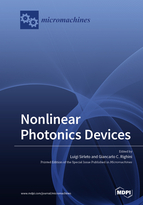Nonlinear Photonics Devices
A special issue of Micromachines (ISSN 2072-666X). This special issue belongs to the section "A:Physics".
Deadline for manuscript submissions: closed (15 December 2019) | Viewed by 49027
Special Issue Editors
Interests: nonlinear optics; ultrafast optics; photonic devices
Special Issues, Collections and Topics in MDPI journals
Interests: glassy and nanostructured materials; integrated optics; optical microresonators; photonic devices
Special Issues, Collections and Topics in MDPI journals
Special Issue Information
Dear Colleagues,
The first nonlinear optical effect was observed in the 19th century by John Kerr. Nonlinear optics, however, started to grow up only after the invention of laser, when intense light sources became easily available. The seminal studies by Peter Franken and Nicolaas Bloembergen, in the 1960s, paved the way for the development of today’s nonlinear photonics, the field of research that encompasses all the studies, designs, and implementations of nonlinear optical devices that can be used for the generation, communication, and processing of information.
This field has attracted significant attention, partly due to the great potential of exploiting the optical nonlinearities of new or advanced materials to induce new phenomena and achieve new functions. According to Clarivate Web of Science, almost 200,000 papers were published that refer to the topic “nonlinear optic*”. Over 36,000 papers were published in the last four years (2015–2018) with the same keyword, and over 17,000 used the keyword “nonlinear photonic*”.
The present Special Issue of Micromachines aims at reviewing the current state of the art and presenting perspectives of further development. Fundamental and applicative aspects will be considered, with special attention paid to hot topics that may lead to technological and scientific breakthroughs.
Papers in all areas of nonlinear optics and photonics will be considered, including but not limited to the following:
Fundamental nonlinear processes in optical devices and systems:
- Active and dissipative effects;
- Attosecond physics;
- Computational analysis;
- Frequency combs;
- Harmonics generation and mixing;
- Instabilities and chaos;
- Nonlinear interactions and non-classical light;
- Nonlinear optics at surface;
- Nonlinear optics in the mid-IR;
- Nonlinear optics with singular beams;
- Optical soliton physics;
- Parametric processes;
- Quantum nonlinear optics;
- Supercontinuum physics;
- Temporal and spatiotemporal effects;
- Ultrafast nonlinear optics;
- Wavelength conversion.
Nonlinear materials and structures related to optical devices and systems:
- Characterization of nonlinear materials;
- Hybrid nonlinear materials;
- Nonlinear effects in glasses, glass-ceramics, and crystals;
- Nonlinear effects in microstructures and microcavities;
- Nonlinear pulse propagation in optical fibers;
- Optical nonlinearities in nanostructures (0D, 1D, and 2D);
- Optical nonlinearities in organic materials;
- Optical nonlinearities in poled materials;
- Optical nonlinearities in semiconductors.
Nonlinear optical devices, systems, and applications:
- All-optical photonic devices;
- Chip-scale nonlinear photonic devices;
- Guided-wave nonlinear devices;
- Integrated nonlinear optical sources;
- Nonlinear detectors;
- Nonlinear dynamics of semiconductor devices;
- Nonlinear microscopy and imaging;
- Nonlinear optical spectroscopy;
- Nonlinear photonic crystals and metamaterials;
- Nonlinear plasmonics and nanoplasmonic devices;
- Parametric oscillators and amplifiers;
- Parametric sources of quantum light.
Both research articles dealing with the latest work in the field and reviews on all aspects of nonlinear photonic theory, materials, and devices will be considered.
Dr. Luigi Sirleto
Dr. Giancarlo C. Righini
Guest Editors
Manuscript Submission Information
Manuscripts should be submitted online at www.mdpi.com by registering and logging in to this website. Once you are registered, click here to go to the submission form. Manuscripts can be submitted until the deadline. All submissions that pass pre-check are peer-reviewed. Accepted papers will be published continuously in the journal (as soon as accepted) and will be listed together on the special issue website. Research articles, review articles as well as short communications are invited. For planned papers, a title and short abstract (about 100 words) can be sent to the Editorial Office for announcement on this website.
Submitted manuscripts should not have been published previously, nor be under consideration for publication elsewhere (except conference proceedings papers). All manuscripts are thoroughly refereed through a single-blind peer-review process. A guide for authors and other relevant information for submission of manuscripts is available on the Instructions for Authors page. Micromachines is an international peer-reviewed open access monthly journal published by MDPI.
Please visit the Instructions for Authors page before submitting a manuscript. The Article Processing Charge (APC) for publication in this open access journal is 2600 CHF (Swiss Francs). Submitted papers should be well formatted and use good English. Authors may use MDPI's English editing service prior to publication or during author revisions.
Keywords
- nonlinear optics
- nonlinear photonics
- nonlinear optical materials
- optical harmonics generation
- stimulated scattering
- optical solitons
- controlling light with light, nonlinear guided-wave photonics
- nonlinear spectroscopy and microscopy








